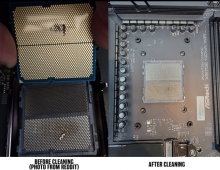
GPUs and Ryzen Processors Help AMD's Financial Figures
Ryzen processors part of a diverse product lineup helped boost AMD's earnings 19 percent compared to a year ago.
For the second quarter, AMD's revenue was up 19% year-over-year to $1.22 billion, and operating income was $25 million for the quarter. Net income was still in the red with a loss of $16 million, resulting in a loss per share of $0.02 on a GAAP basis. Gross margin was 33%, hovering right around that 35% range that AMD wants to hit for profitability.
Ryzen and the Computing and Graphics segment had a very strong quarter, with revenues of $659 million, up 51% compared to Q2 last year. Operating income for the Computing and Graphics group was $7 million, compared to an $81 million loss last year, and much of that was driven due to higher average selling prices for its processors. Although AMD is not yet able to charge the premium of Intel, it can at least charge a lot more than it did for the last generation of CPUs.
Enterprise, Embedded, and Semi-Custom had a 5% drop in revenue, to $563 million, mostly due to a softening in semi-custom SoC sales. This segment is where AMD's EPYC CPU line will impact in the next quarters, with the launch of the Xbox One X, and EPYC.
All Other had an operating loss of $24 million, compared with a loss of $11 million in Q2 2016, with this primarily being stock-based compensation, as well as a $7 million restructuring credit in Q2 2016 helping out that quarter.
During an investor call, AMD's executives said that game developers had largely completed their code optimizations for Ryzen, and that miners who hoarded graphics cards wouldn't be around forever. Gamers have struggled to find available graphics cards because cryptocurrency speculators have snapped up the available supply.
Next quarter, AMD predicts a whopping 23-percent sequential growth in revenue.





















